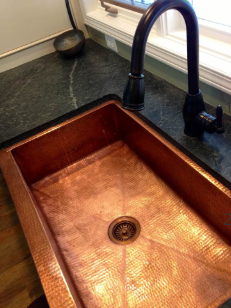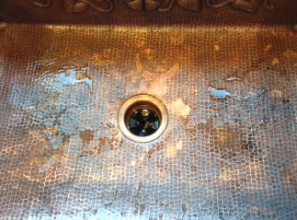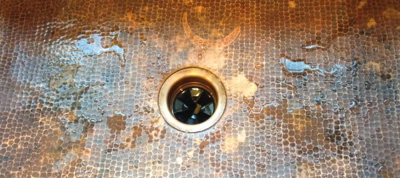People have different preferences when it comes to copper tones. For those who pay close attention to color variations and want to “fix” their copper sink of these variations whether man-made or natural, here you will find useful information and directions to guide you through do-it-yourself methods for correcting unwanted copper patina colors.
Restore a Bright, Raw Copper Color

There are a couple of different ways of treating a copper sink that has developed inconsistencies, marks, or undesirable looks with the patina finish.
- Most any copper cleaner (readily available at grocery or hardware stores) when used as directed, should remove all the discoloration and patina from the copper sink, and leave it with a bright, new copper color finish.
- When the copper has an even tone all over after cleaning, use a product like Renaissance Wax to protect the copper and slow the natural patina process. The wax will act as a temporary barrier to elements and substances that come into contact with the copper, and the wax will also encourage beading and shedding of most liquids, much like wax on the exterior of a car or boat. Use the wax sparingly and as directed, and apply once every 4-6 weeks, depending on the daily use of the copper sink. Keeping the bright shiny look will require regular polishing with a commercial copper polish. You can extend the time between polishing with an application of Renaissance Wax.
If you start with a bright, raw copper tone but desire a natural patina look of milk chocolate, caramel or pumpkin pie hues, you will need the patience to let nature (water and oxygen) takes its course on the copper over time.
Darken a Shiny Spot in Your Patinaed Copper Sink

To fix a shiny spot in your dark copper sink, or to develop a darker patina finish on the sink manually rather than naturally, we suggest patience first. Copper has a living finish, and although it's tempting to try to find a quick fix, the BEST solution is to let the copper sink build patina back on its own, naturally over time.
The following two products can be used to jump-start the patina development process, but are not an instant solution to a shiny spot: Jax Brown-Black Copper Darkener, and 2. Liver of Sulphur (both available through Amazon or other online outlets). Both of these products require patience and a little technique for successful results. Apply a small amount of the liquid (according to the instructions on the product) to the sink. Let the solution sit on the copper for a few minutes until your sink reaches the desired color.
Another option: There is a home remedy that you can mix yourself to help speed up the patina process. It consists of 1/4 cup of ammonia and 1 teaspoon of salt. (Do not use any lemon products.) You can drop or dab it onto specific, affected areas, leave on for 30 minutes and then rinse off and repeat as needed. Patience is key. Copper naturally develops patina color when it's exposed to water and oxygen, and these solutions are only meant to jump-start the natural copper patina process.
When the new patina color blends with the neighboring area, apply a thin coat of Renaissance Wax to help protect and maintain this patina finish you just created—use sparingly and apply every 4-6 weeks.
Rules of Thumb To Preserve Your Copper Patina Color
Results may vary, depending on application technique. Keep in mind that copper is a natural element that constantly changes color with anything that comes into contact with it. Being cautious about substances that might stay on the surface of your copper sink is good practice to minimize those undesirable patina marks, dark or light. A quick rinse with water after every use is recommended. Here is a list of commonly used items or foods that can remove patina from copper:
Strong or abrasive cleaners (Copper is naturally antimicrobial; no bleach is necessary to sanitize copper)
- Sponges with a scrubby-side
- Toothpaste often contains peroxide or even bleach that will remove the patina finish off copper, as do a variety of other common personal use items
- Foods/liquids high in acidity: any citrus fruits, tomatoes, vinegar or pickled foods, alcohol, spicy foods, coffee, and juices
Be sure to rinse the sink immediately after any of these things have been used to make sure they do not linger on the surface of the sink for an extended period of time. Leaving foods or liquids on the copper will not harm the sink, and the patina will return in time. If you live in an area where the water has a high mineral content, you may choose to wipe down the sink with a soft cloth to avoid water spotting or mineral build up.
If you develop a shiny spot in your dark copper sink, DO NOT wax your entire sink! You only want to wax the color you want to preserve. We recommend waxing AROUND the shiny spots so that water and oxygen can get to the raw copper and begin to develop a patina. The best practice is to follow the steps above to manually jump-start the patina process, and only wax the sink once you've achieved the desired color.
Regardless of which patina color you choose, copper is a beautiful living element, and never really stops changing in color. It will lighten and darken with use and develop its own charm and character. When you own a copper sink, it is like having a simple and harmless science experiment you can play with every day! Patience and understanding of what copper is and how it reacts make owning a copper sink interesting and fun.





